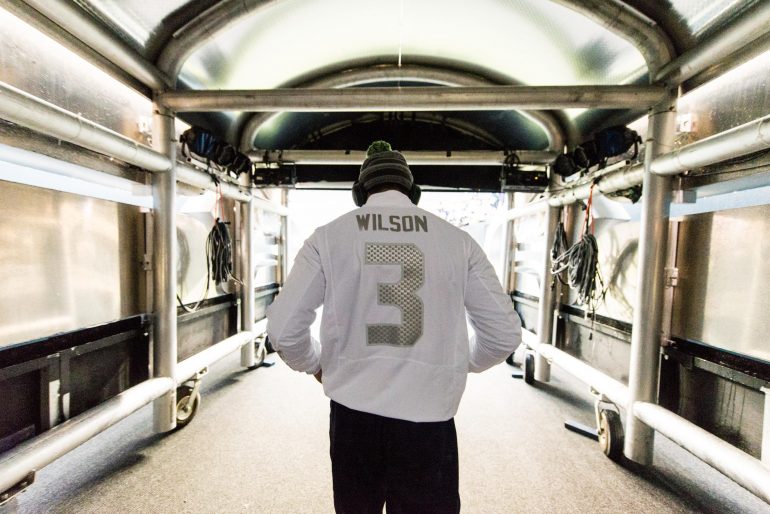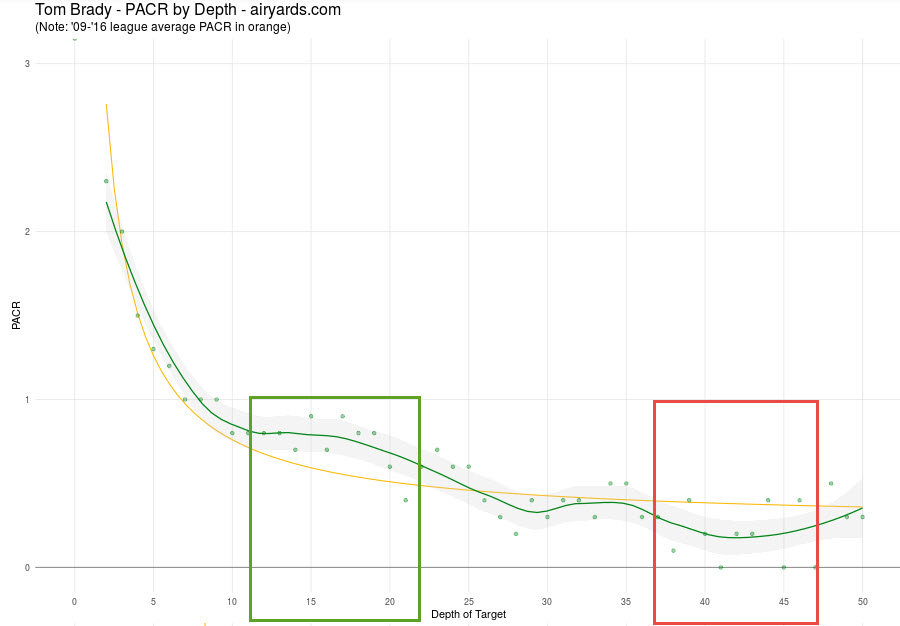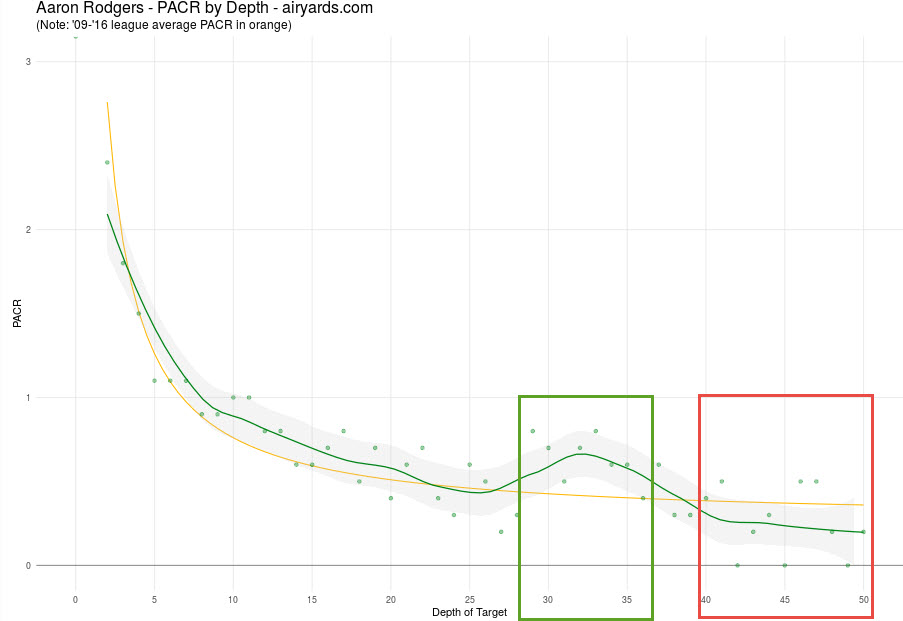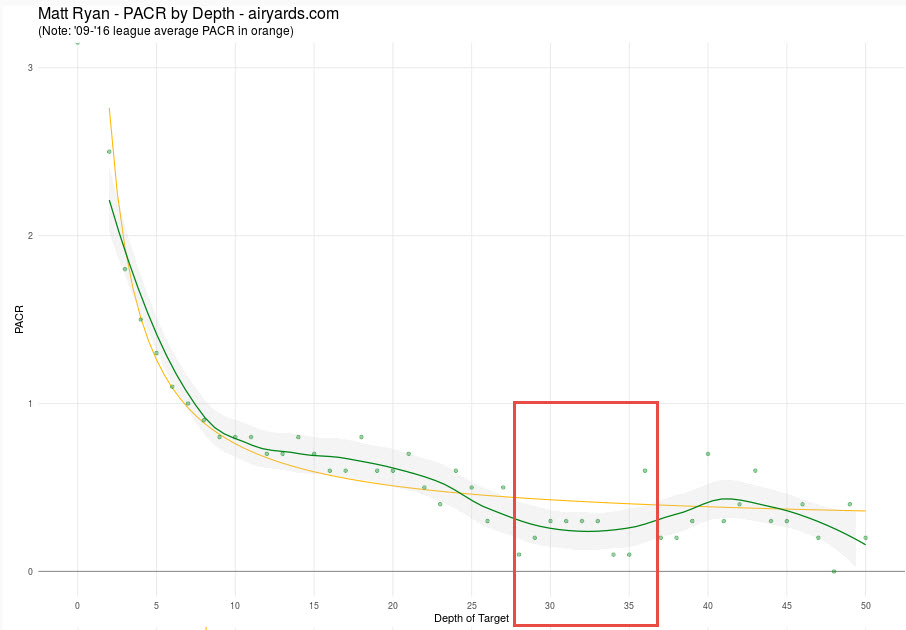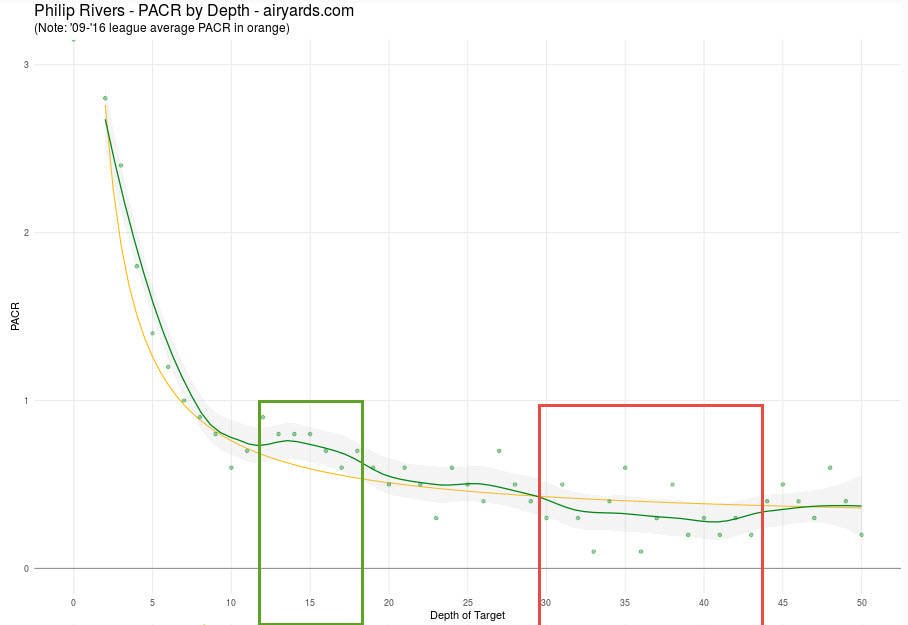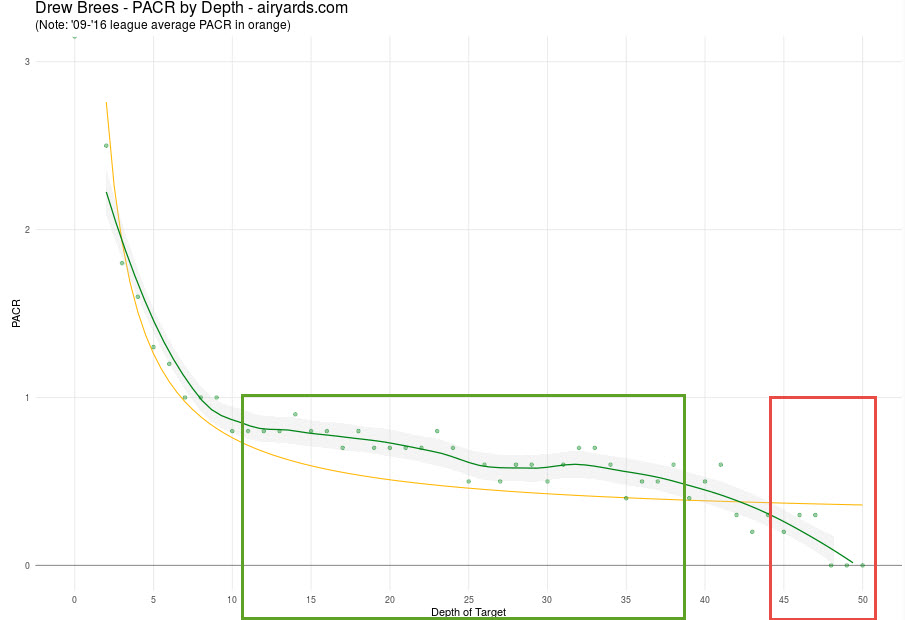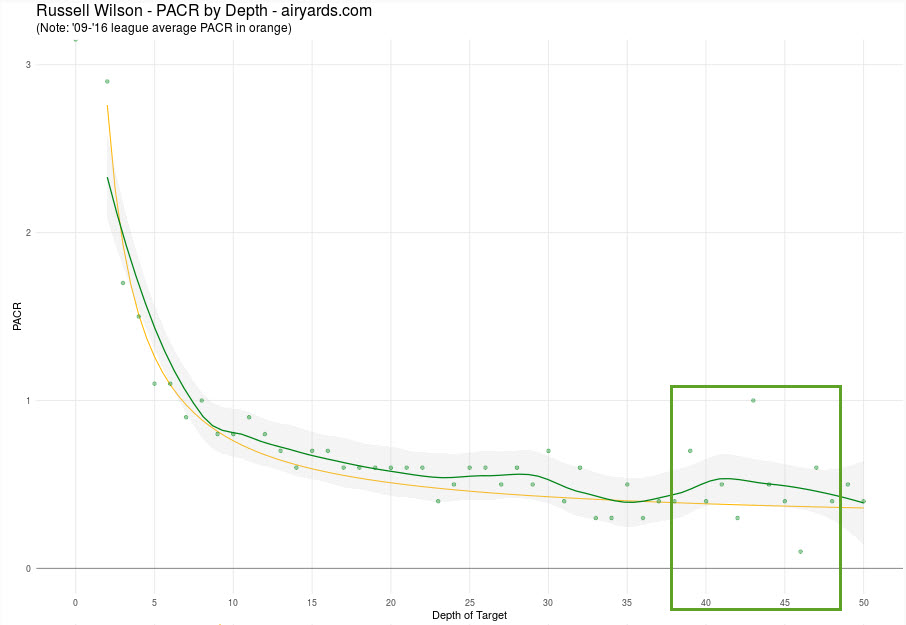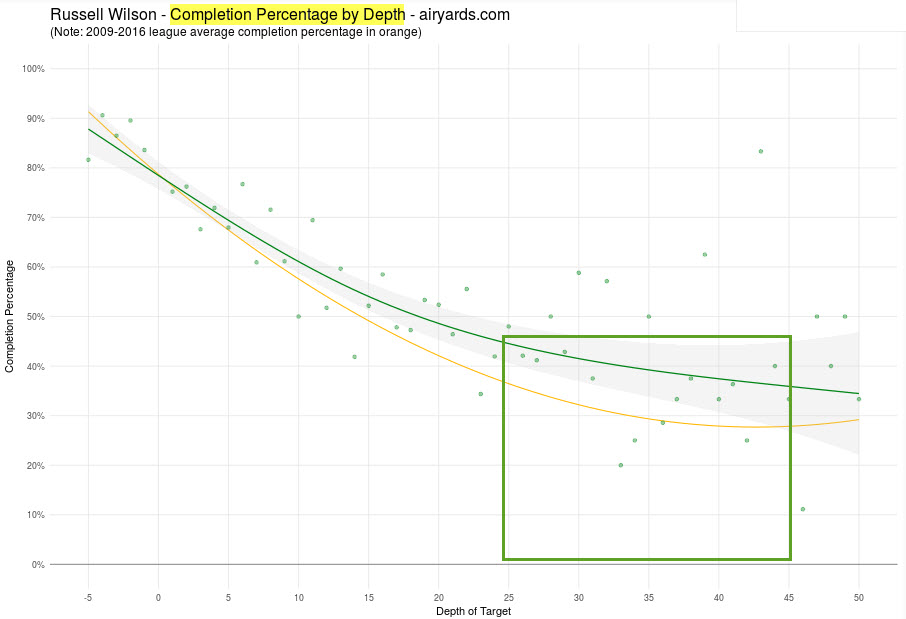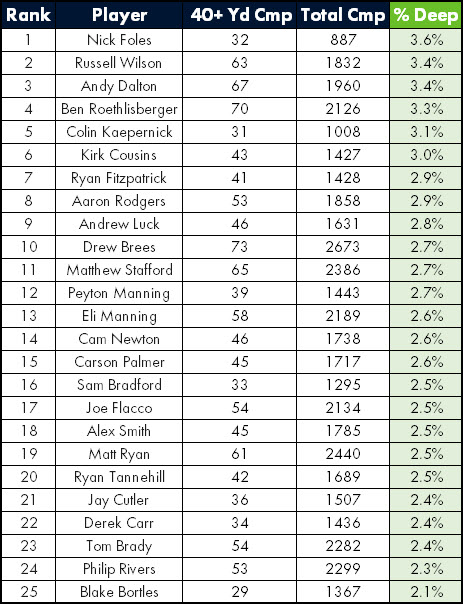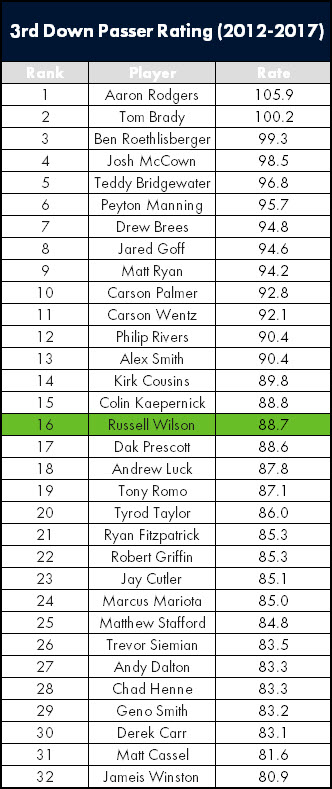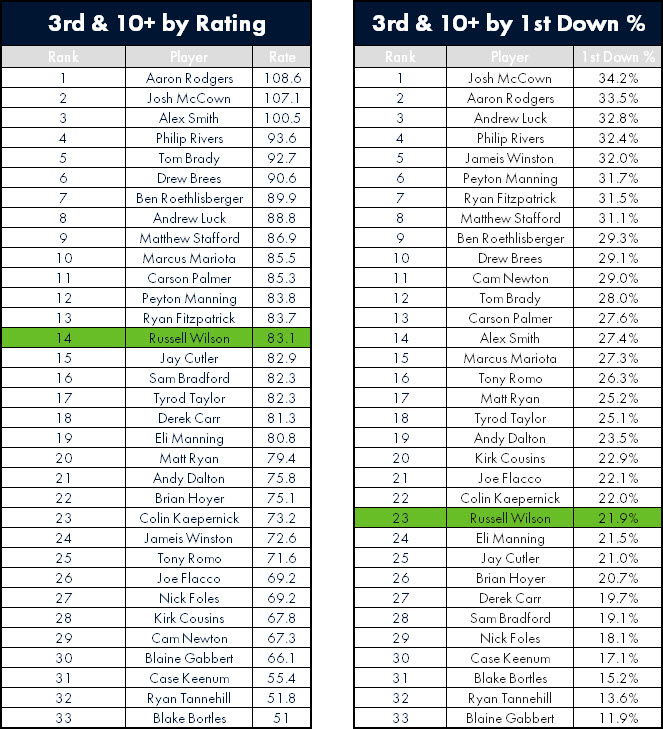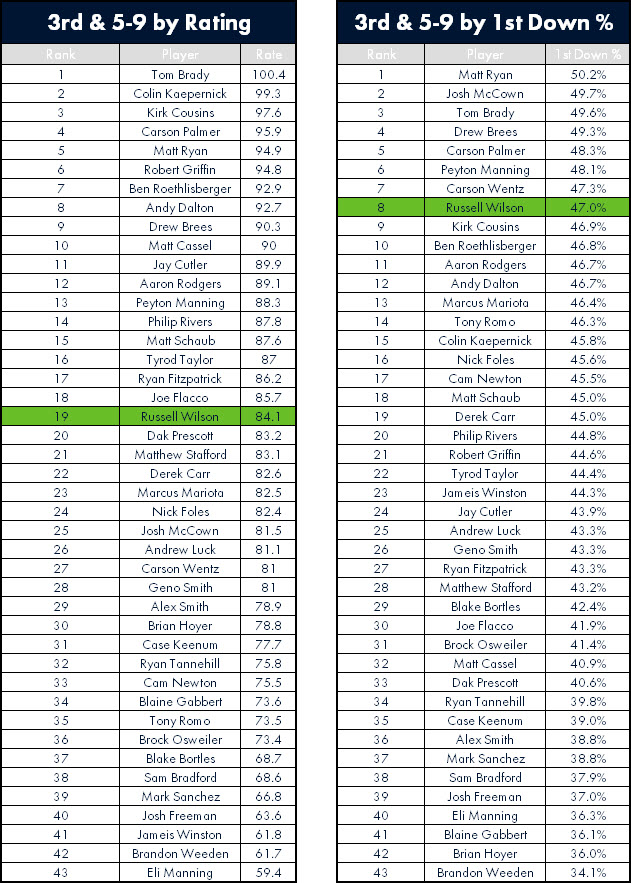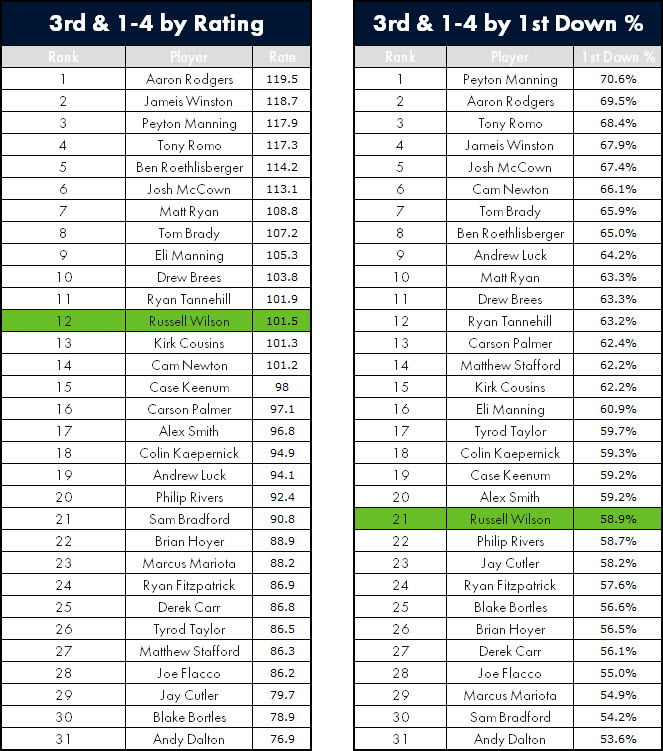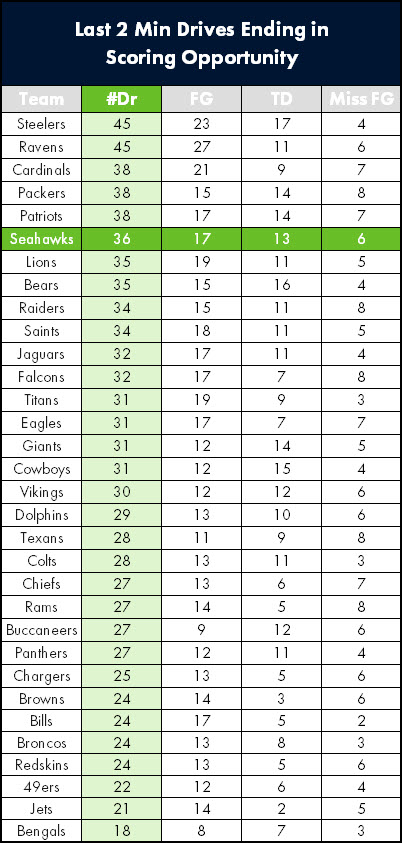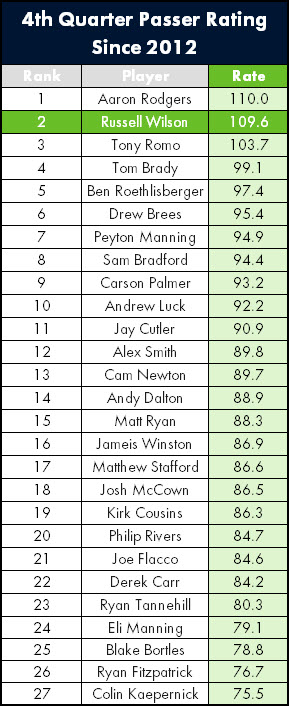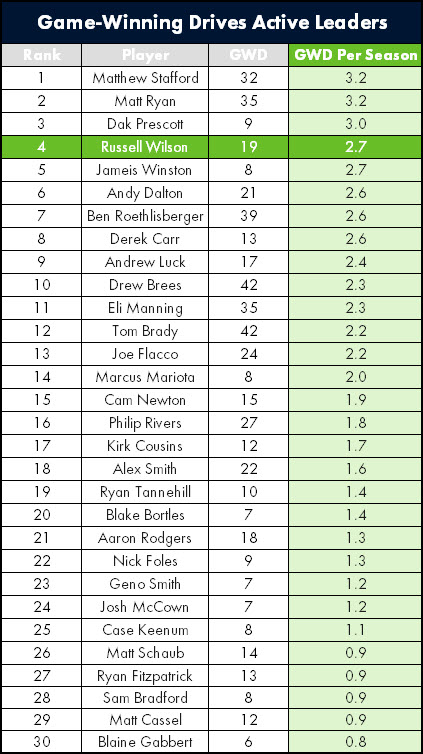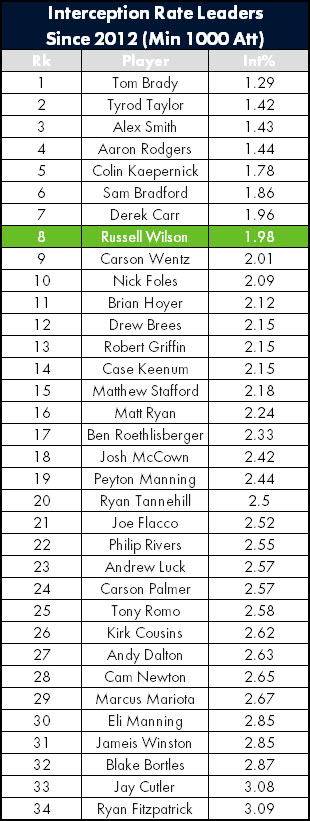Complexity is uncomfortable. The human craving for simplicity has shaped how we tell stories, how we solve problems, and even how we pass time. People are good or evil. Answers are right or wrong. Sports provide the satisfaction of winners and losers (usually). Challenge someone to see nuance and broach the possibility that something may be unknowable, and most people react with resistance or even anger. It should come as little surprise, then, that the subject of our very own Russell Carrington Wilson suffers from oversimplification. He is unassailable to some, and hopelessly limited to others. The truth, as is so often the case, requires more than 140 (or 280) characters and milliseconds of reflection. The following is how I see Wilson. It is based on qualitative and quantitative research. Even then, it is flawed with my biases. The goal is to add more specificity to the discussion of a critical figure in the Seahawks past, present, and future.
Russell Wilson is an excellent deep passer
Quarterbacks will tell you they have favorite routes. Offensive coordinators will tell you they work to identify the throws their quarterback does best to help accentuate their strengths. There tends to be more discussion of throws Wilson struggles with than ones at which he excels. His ability to throw the deep ball is one of his greatest assets. Not only is he terrific at this skill, but it’s a blast to watch as a fan. Despite what you may have heard, everybody digs the long ball.
To help illustrate this key strength of Wilson’s, I first want to leverage the great work of Josh Hermsmeyer over at airyards.com. One of the unique metrics that he tracks is PACR, which stands for Passer Air Conversion Ratio. It is calculated by taking a player’s total passing yards and dividing them by their air yards. Air yards are how far the ball traveled in the air versus yards gained after the catch. Hermsmeyer claims that PACR is “the most predictive metric for quantifying QB passing efficiency.” He provides some great charts for quarterbacks to show their PACR versus league average by depth of target. In other words, how efficient is a quarterback depending on how far of a pass they are throwing.
I have tried to help the metrics-averse crowd by placing red and green boxes around weak and strong aspects of QB throws.
As you can see, Tom Brady has become the greatest QB in NFL history without being great at every aspect of the position. He is a perfect example of a player whose strengths have been accentuated with a scheme that fits. Brady excels at intermediate throws. Fortunately for him and Patriots fans, those are far more common because they require less time to protect and are generally higher percentage throws. Brady has never had a particularly strong arm, and that shows up in deeper throws where his PACR is well below league average. Really, after about 25 yards, Brady is consistently below league average.
Aaron Rodgers also gets “best quarterback in the game” hype. His curve is much different than Brady’s, and I would argue, indicates he has a better arm that is capable of a wider array of throws. Whether that makes him a better QB is separate debate for someone else to take on. We can see that Rodgers’ stands out in the 30-35 yard range and dips below league average after around 40 yards.
Matt Ryan is not quite the opposite of Rodgers, but he falls below league average where Rodgers was strongest and climbs above the average between 40-45 yards. Like Brady, he is strongest on intermediate throws. Albeit, not as strong as Brady.
Philip Rivers makes his living on the shorter throw, below even 20 yards downfield. He is generally below league average after 30 yards.
Drew Brees stands out from the crowd. The dude is well above league average from 10 to almost 40 yards downfield. My first reaction when I saw this was that Brees does not get enough mention in the best QB in football conversation. Offensive coordinators have a full menu at their disposal with a guy like this pulling the trigger. His efficiency does dive beyond 45 yards, but it is hard to care given his performance the rest of the way. Again, the deeper the throw, the less frequent they are attempted.
The first thing that jumps out with Wilson is that he does not have a glaring weakness. There are areas where he is pretty close to league average, never below. His best showing comes beyond 40 yards where almost every other QB dipped. We can see his strength here from another angle.
This chart looks the same, but it is actually completion percentage instead of PACR. You can see how the rest of the league dips heavily as depth of target increases where Wilson starts to flatten out around 25 yards. The gap between him and the average QB on these deep throws is significant. It is important to note that as good as Wilson is at these throws, they are still completed less than half the time. The amount of things that has to go right for a play like this to work is simply greater than a shorter throw, and why offenses are designed around more repeatable throws closer to the line of scrimmage.
One final bit of evidence to share on this deep throw topic is the percentage of passes Wilson has completed that are 40+ yards. The following table looks at the top 25 players from 2012-2018 in completions of 40 yards or greater. It then sorts by the percentage of their overall completions that were over 40 yards.
Unlike the air yards charts above, these completions include yards after catch, so they do not align perfectly to depth of a target. Someone could have thrown a swing pass to a running back at the line of scrimmage and seen him run 40 yards and it would count here. Still, Wilson is darn near the top of the list. As advertised, Brady is well down the rankings all the way at twenty-three.
Statistics aside, Wilson shows a willingness to trust receivers down field and give them a chance to make plays. His most productive deep connection was Golden Tate, who was a perfect match with his ability to outleap defenders and terrific hands that pulled the ball away from traffic. Wilson has a great trajectory on these throws, neither too shallow nor too high. His accuracy is remarkable, and is helped by his trajectory that allows receivers to either catch up to the pass or adjust their route and prepare to leap. For my money, Wilson is the best deep passer in football, especially when you combine it with some of his other strengths we will discuss later.
Russell Wilson is average on 3rd down
Some will read that as he is a bad third down QB. If he was bad, I would have written that word. He is middle of the pack. How close to the middle? One way to assess that is his passer rating on 3rd down. I looked at the QBs with the most third down pass attempts since Wilson has come into the league, and then sorted them by passer rating.
Wilson ranks 16th out of the top 32 quarterbacks. Average. He is above Andrew Luck, which will make some folks smile. I wanted to dig a little deeper, so I decided to break down 3rd down performance by yards to go. Looking at just passer rating does not capture some of what Wilson can do with his legs, so I also calculated the first down rate based on both passing and rushing first downs, as well as passing and rushing touchdowns, divided by pass attempts, rush attempts, and sacks. It is not a perfect metric, but gives us another lens by which to look that factors in rushing. The following tables include quarterbacks who had at least 100 pass attempts in this situations between 2012 and 2018. That is why you will not see the same names or same number of players listed.
Wilson ranks 14th in passer rating when facing a 3rd and 10 yards or longer. Compare that to guys like Aaron Rodgers at a remarkable 108.6, and even Brady and Brees over 90.0 and the separation is apparent. Get used to seeing Josh McCown high on these rankings. It makes you wonder what kind of quarterback he could be if he stayed healthy and a team believed in him. When you switch over to the first down percentage, Wilson drops down further in the rankings. An interesting oddity is Jameis Winston, who ranks 24th in passer rating in 3rd and more than 10 yards to go, but jumps to 5th in first down percentage.
Winston has a knack for making big plays in these situations, but he also has a penchant for throwing interceptions. He has a whopping 6.1% interception rate, which is tied with Cam Newton for highest among these quarterbacks. That’s roughly 4X Wilson’s 2.3% interception rate. You can imagine why a player like that drives coaches crazy. The fact that guys like Rodgers and Rivers convert these sorts of situations into successful outcomes a third of the time is remarkable. Wilson is roughly successful one out of every five times.
Wilson ranks 19th in passer rating when the distance drops down to between 5 and 9 yards to go, but rises all the way to 8th in successful outcomes. That ranking of 8th is the highest of any slice on 3rd down for Wilson. Part of that is due to an increased opportunity to convert using his legs. Nearly 13% of the first downs he recorded in these situations came via rushing, which can include scrambles on pass plays.
Most quarterbacks rating rises as the distance gets shorter, as does their ability to achieve successful outcomes. You might think Wilson’s legs become an even bigger benefit in these moments, but his 17.9% rushing first downs in roughly the same range as guys like Rodgers (16.9%), Luck (20.7%), Kaepernick (17%), Keenum (16.9%) and others. Guys like Newton (46%) and Taylor (34.2%) are far more reliant on their legs in these moments.
Outside of ranking 8th in successful outcomes on 3rd and 5-9 yards, Wilson is near average or below average in 3rd down situations. The last thing I wanted to check was to see whether Wilson was being weighed down by poor performances when he was younger and less experienced. Trending his 3rd down passer rating each year does not indicate things are improving.
Wilson had an insane stretch of play over the last eight games of the 2015 season. His play on third downs was a huge part of it as he registered an eye-popping 137.5 passer rating. That helped him achieve a career-best 117.3 on that down for the season. He has been unable to replicate that kind of success in any other meaningful stretch of play. In fact, his performance has dropped considerably over his last two seasons, including a career low last season.
I included a chart of where the team ranked on third down conversions each season, and you can see it roughly tracks to Wilson’s passing performance. The big exception is 2014 when Wilson ran for a career high in yardage. That helped Seattle finish a respectable 11th in conversions despite just a 77.1 rating for Wilson.
Opponents save some of their most exotic looks for third down. Being able to read a defense before the snap to identify the most likely weakness, adjust protections and play calls to take advantage of those weaknesses and blunt attacks, and decisiveness are skills that come to the fore in these moments. Some of those things cannot be diagnosed on film. How many times do you see Brady or Rodgers recognize something before the snap, make an adjustment, and decimate a defense? The absence of those adjustments or making the wrong read and adjustment does not show up on all-22.
Decisiveness does show up to some degree on film. This is an area Wilson tends to struggle. The one time in his career where he consistently was getting the ball out of his hands quickly on third down was in 2015 during that stretch of great play. That is not all on Wilson. Offensive line play, play-calling, and a host of other factors impact Wilson’s success. That is true, though, of all plays. This is a particular aspect where he is not among the better quarterbacks in the league.
Russell Wilson is uncommonly poised and clutch
Anyone who has watched Wilson play has seen his heroics. Some of his best moments have directly followed some of his worst. The NFC Championship against the Packers comes to mind. We know Wilson is great in the last two minutes of the first half or the game. We also know he plays some of his best football when the team falls behind. Let’s see how he stacks up with other players in those situations.
Wilson ranks sixth among all quarterbacks since 2012 (minimum 100 pass attempts) in passer rating in the last two minutes of either the second or fourth quarter of the game. He is slightly ahead of Brady, and a decent chunk ahead of Rodgers in these situations. Wilson’s penchant for clutch play in the final two minutes has unsurprisingly led to a bushel of scoring chance for the Seahawks in these situations. Look at the number of times Seattle has either scored, or had a chance to score in drives starting in the final two minutes of either half.
Seahawks fans may take some solace in the side note that plenty of teams have more missed field goals in these situations even if it has felt differently. Wilson has been a key part of the team’s success in these moments. If you broaden the lens and just look at how he performs in the final quarter of a game, he stands out even more.
Only Rodgers has a higher fourth quarter passer rating since Wilson entered the league. If you are confused about how Rodgers has such a high rating in this table when he was lower in the previous, remember that the first table was the last two minutes of either the first half or the second half. This is the entire fourth quarter. Take a look at the names in the top ten. Outside of Sam Bradford, it is a who’s who of elite quarterbacks. Chargers fans are probably knowingly shaking their heads at Rivers being so far down this list.
Wilson’s strength in the final quarter has led to a number of game-winning drives. In fact, Wilson set the NFL record for most game-winning drives through a player’s first four seasons, according to Football Outsiders. He ranks 11th of all active quarterbacks on the list of most game-winning drives, despite playing far fewer seasons than most. When looking at the per-season numbers, he jumps to fourth.
Wilson has consistently raised his level of play when the game is on the line or the Seahawks are behind. Some of his largest statistical games have come in games where the Seahawks trailed by large margins and he piles up huge totals of passing yards and touchdowns. The loss to the Titans and the Jaguars last year are just two examples. The loss to Atlanta in the 2012 playoffs is another. He has shown this knack for coming alive when hope appears lost in both the regular season and the playoffs. It is understandable that most of the focus from their last Super Bowl appearance was the interception he threw, but he made a series of terrific plays on that drive to lead the team to the precipice of winning. He even led an almost impossible touchdown drive just before the first half ended in that game that many forget.
This trait is one of Wilson’s most valuable.
Russell Wilson is not elite in the red zone
As great as Wilson can be at leading his team to points when they fall behind or in the final minutes of a half, he is not elite when his team enters the red zone. The reasons are challenging to diagnose. He has had elite red zone targets in Doug Baldwin (yes, Doug Baldwin) and Jimmy Graham, as well as a great red zone runner in Marshawn Lynch. It took over two years for Wilson to get comfortable throwing fade patterns to Graham. It never quite looked natural, but his progress there helped a dramatic jump in the Seahawks red zone touchdown rate from 2016 to 2017.
There are some similarities between red zone situations and third down plays. Decisiveness, anticipation, and ability to identify risks worth taking are important attributes. Wilson has been saddled with what many considered a poor red zone play caller in Darrell Bevell until this season. That plays a significant factor, and it is possible that a better coordinator could unlock more of Wilson’s potential in this important part of the field.
Until that marriage occurs, we can only assess what Wilson has done thus far, and it’s been pretty darn average.
One thing I was curious about when I saw this data was what were some differences between 2012, when Wilson was great in the red zone, and some of the more recent years where he has been more middling. There definitely an offensive explosion late in his rookie season when the read option took off and Wilson was trusted more by the coaching staff to cut it loose. But that year was also marked by a heavy reliance on the run game to lessen the load on the young quarterback. I pulled some numbers to see if that was also the case in the red zone.
Sure enough, Seattle ranked 10th in the league in percentage of play calls that were running plays (52.9%) in 2012, and just 30th in the NFL in rush percentage in the red zone (37.7%) last season. Seattle was historically bad running last year, especially in the red zone, so it makes sense that they put less emphasis on it. Even the year before, though, they were 21st in red zone rushing rate (42.9%). That’s a big shift from where Wilson was at his best. Perhaps, having more defenders committed or cheating to stop the run opened up more space for the pass or created greater opportunity to catch the defense off-guard through the air. Or, it may just be that the league learned more about the types of red zone throws Wilson prefers and adjusted. There are probably a dozen other good theories as to why Wilson has not recreated his red zone success from his rookie season, but the reality is he is not one of the best red zone passers in the league.
Russell Wilson is a talented play action passer
One of the things that most excited me about the idea of the Seahawks taking Wilson leading up to the 2012 draft was seeing how comfortable he was making throws off of play action. A lot of quarterbacks struggle with turning their backs to the secondary to fake a hand off and then locating their receiver and making an accurate throw. Wilson showed uncommon comfort with these types of plays during his time at Wisconsin.
Knowing how important the run game was to Seattle, this felt like a perfect match. It has largely proven to be a strength during his NFL career.
You can see that Wilson has been consistently above 94.0 in play action passer rating, and is currently sporting a near perfect rating of 158.3 on such passes through two games this season. His ranking relative to other quarterbacks has bounced around, but his efficiency has remained strong throughout. When looking at passes where there was not play action involved, you can see a couple of troubling numbers in 2016 and so far in 2018. Wilson has consistently ranked among the most efficient non-play action passers most years as well.
Russell Wilson is excellent at throwing on the move
Related to the play action strength is Wilson’s ability to throw with accuracy while on the run. This can happen on-script with plays like bootlegs and sprint outs, and during his famous off-script scrambles. I was unable to find data to prove or disprove this point, but feel strongly this is one of the things that makes Wilson special.
Russell Wilson is excellent at limiting interceptions
Wilson is not the most decisive thrower, in part, because he values the football. Anyone in human resources can tell you that a strength pushed to the extreme can become a weakness. Wilson’s innate desire to make the right decision and keep the ball out of harm’s way can become a barrier to greater success in situations like third down or the red zone where quicker reads and decisions are paramount. That should not keep us from recognizing how fortunate we are to have a quarterback who limits his interceptions.
Closing thoughts
Wilson clearly has tremendous strengths and some areas that are less strong. There are not many areas that stand out statistically as being below average. One thing that are nearly impossible to evaluate through numbers or through watching film is pre-snap reads. Is he correctly identifying what the defense is trying to do so that he can adjust the play and protection if need be, and know where his first read should be after the snap? Only people in the huddle and on the coaching staff know the answer to that.
My assessment is that it is still an area where he has considerable room for improvement. I believe he is well behind guys like Brady, Rodgers, and Brees in getting his team out of bad plays and checking into good plays. I also believe there are a number of plays that would have worked had he been willing or able to run the play as designed. Greg Cosell is an excellent analyst, and has commented on a number of occasions that while he has great respect for Wilson as a player, there is a lot of film that shows him holding onto the ball when there is an open receiver in front of him. It is not clear if this is because Wilson is unable to see the player due to his height or simply overthinking and being indecisive. Whatever the reason, it remains an area of growth.
Wilson is clearly one of the best runners at his position in league history. The additional yardage he accumulates there has been instrumental to the Seahawks offense. I did not spend as much time on that here because it will be less a part of his game as he gets older, and my focus was more on who he is as a passer.
When Wilson is at his best, he is playing with aggression and pace. It is both awesome and confusing to see a player so consistently transform from indecisive and ineffective to commanding and unstoppable in the same game. Many people think the Seahawks should move to more uptempo offense earlier in the game. That might help, but I do not believe it is that simple. Other factors, like Wilson’s competitive fire when trailing and changes to defensive schemes when ahead, come into play.
His talent for throwing the deep pass becomes less impactful when the offensive line cannot protect long enough to allow the play to develop. That has been especially true the past two seasons, and through two games this year.
There has been a lot of evidence that the quality of your rushing attack has no bearing on the effectiveness of play action passing. As counter-intuitive as that might be, it does not account for a coaches likelihood to call a play action pass when they have been ineffective running the ball. Well over 30% of Wilson’s passes were of the play action variety his first three seasons in the league. He ranked 2nd, 1st, and 4th in play action percentage among qualifying quarterbacks those years. It dropped to 24% in 2015, 22% in 2016, and stayed around 22% in 2017, which ranked 18th in the league. Through two games this season, that percentage is down 14.1% and ranks 28th. Seattle has been under-utilizing one of Wilson’s greatest strengths that past few years.
Those are two key strengths that Seattle has been less capable of capitalizing on of late. It has led to more reliance on development in areas where Wilson is less strong. When Pete Carroll said he wanted to give Wilson a master’s class in the position over an offseason a few years ago, I believe he was talking about reading defenses and making adjustments before the snap. I also believe they want to see Wilson throw more on time and on script than he has up until this point in his career.
Those are worthy goals that will unlock a whole new level of achievement if and when Wilson meets them. As it stands, the Seahawks offense has lost the rushing attack that worked so well as a compliment to Wilson’s strengths, completely bungled the offensive line in front of him, and never game him a quarterback coach or coordinator who could teach him that master’s class Carroll acknowledged was needed.
Saying that Wilson is flawless and that every poor play is the fault of someone else is simply false. Saying that Wilson is trash and his success is purely the result of others is also false. The complex truth is that Wilson has a collection of talents that can be part of a Super Bowl team, while also having some areas of development that keep him from reaching the level of more consistently stellar play that guys like Rodgers, Brees, and Brady have achieved. The places where Wilson struggles can make it tough to find the right coach and system, but when it clicks, few players are harder to stop.
This eighth season of his career represents a transition from a guy who entered the league surrounded by Super Bowl talent to one that is among the furthest away. He will be under the spotlight in a different way than before. The team needs him to evolve, and he needs the team to leverage his strengths. Pardon our mess. Under construction.
